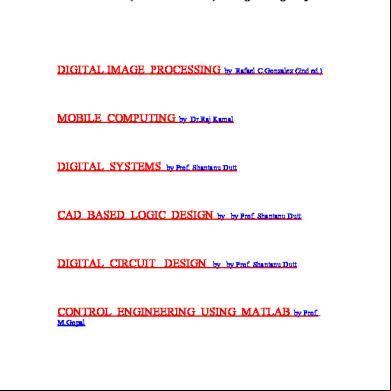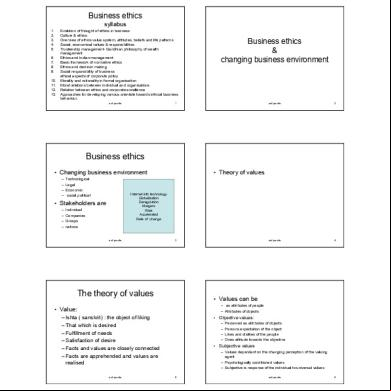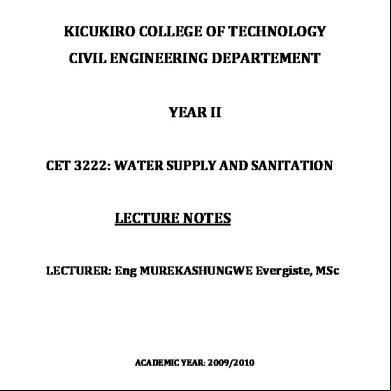Bookkeeping Lecture Notes 1gh60
This document was ed by and they confirmed that they have the permission to share it. If you are author or own the copyright of this book, please report to us by using this report form. Report 3b7i
Overview 3e4r5l
& View Bookkeeping Lecture Notes as PDF for free.
More details w3441
- Words: 1,106
- Pages: 1
The s of Financial Statements 1. Investors/ Shareholders – use the FS to make important investment decisions with a firm. 2. Creditors – use the FS to make significant decisions in granting credit with an enterprise. 3. Employees and Labor Unions – use FS to judge the fairness of wages, future job prospects and bargain for better wages. 4. Regulators – often have legal authority over certain activities of organization such as BIR, SEC and BSP. 5. Customers – use the financial information about the continuance of a company especially when they have a long-term involvement with or are dependent on the entity. 6. Public – use the financial information to assess the contributions of the entity to the economy such as number of people they employ and their patronage of local suppliers. The ing Equation The ing Equation reflect the sources of the company’s assets: the funds generated by the creditors through short term and long term borrowing and the funds provided by its owners / shareholders in a form of initial investment in a form of cash and non-cash assets. Thus, the ing equation is expressed in this way: ASSETS = LIABILITIES + OWNER’S EQUITY This equation can be rearranged to:
ASSETS – LIABILITIES = OWNER’S EQUITY
The Breakdown of Equity yields the following expanded ing equation: ASSETS = LIABILITIES + OWNER’S CAPITAL – OWNER’S WITHDRAWALS + REVENUES – EXPENSES Assets – represent the economic resources owned or controlled by a company that yields future benefits. Examples are cash and cash equivalents, short-term investments/marketable securities, trade and other receivables, inventories, prepaid expenses, unused office supplies, property, plant and equipment such as land, office and store equipment, office and store furniture and fixtures, building, vehicles and machineries and intangible assets which include goodwill, franchise, trademarks, patents, copyrights, etc. Liabilities – are creditor’s claims on assets. The term payable refers to a liability that promises a future outflow of resources. Examples are s payable, note payable, bank loan payable, accrued expenses or expenses payable, deferred or unearned revenues. Equity – is the owner’s claim on assets. Equity is equal to assets minus liabilities and commonly referred to as net asset or residual equity of the company. The company investment and revenues increase the equity while withdrawals and expenses normally decrease the . The Basic Financial Statements The basic financial statements are the following: 1. The statement of financial position – it shows the financial condition of a business entity in of assets, liabilities and equity. 2. The income statement – it reflects the financial performance of a company in of net income or net loss. Total revenues generated by the enterprise for a given period are reported together with the total expenses incurred are shown in this statement. 3. The statement of cash flows – it highlights the sources and use of cash of the company which covers three parts: the operating, the investing and financing activities. 4. The statement of changes in equity – shows the movement of capital in of initial and additional investments, withdrawals and effects of net income or net loss in this . 5. Notes to Financial Statements – significant disclosures are very important which includes the ing policies, background of the company and the breakdown/details affecting all the s of the FS.
The s of Financial Statements 1. Investors/ Shareholders – use the FS to make important investment decisions with a firm. 2. Creditors – use the FS to make significant decisions in granting credit with an enterprise. 3. Employees and Labor Unions – use FS to judge the fairness of wages, future job prospects and bargain for better wages. 4. Regulators – often have legal authority over certain activities of organization such as BIR, SEC and BSP. 5. Customers – use the financial information about the continuance of a company especially when they have a long-term involvement with or are dependent on the entity. 6. Public – use the financial information to assess the contributions of the entity to the economy such as number of people they employ and their patronage of local suppliers. The ing Equation The ing Equation reflect the sources of the company’s assets: the funds generated by the creditors through short term and long term borrowing and the funds provided by its owners / shareholders in a form of initial investment in a form of cash and non-cash assets. Thus, the ing equation is expressed in this way: ASSETS = LIABILITIES + OWNER’S EQUITY This equation can be rearranged to:
ASSETS – LIABILITIES = OWNER’S EQUITY
The Breakdown of Equity yields the following expanded ing equation: ASSETS = LIABILITIES + OWNER’S CAPITAL – OWNER’S WITHDRAWALS + REVENUES – EXPENSES Assets – represent the economic resources owned or controlled by a company that yields future benefits. Examples are cash and cash equivalents, short-term investments/marketable securities, trade and other receivables, inventories, prepaid expenses, unused office supplies, property, plant and equipment such as land, office and store equipment, office and store furniture and fixtures, building, vehicles and machineries and intangible assets which include goodwill, franchise, trademarks, patents, copyrights, etc. Liabilities – are creditor’s claims on assets. The term payable refers to a liability that promises a future outflow of resources. Examples are s payable, note payable, bank loan payable, accrued expenses or expenses payable, deferred or unearned revenues. Equity – is the owner’s claim on assets. Equity is equal to assets minus liabilities and commonly referred to as net asset or residual equity of the company. The company investment and revenues increase the equity while withdrawals and expenses normally decrease the . The Basic Financial Statements The basic financial statements are the following: 1. The statement of financial position – it shows the financial condition of a business entity in of assets, liabilities and equity. 2. The income statement – it reflects the financial performance of a company in of net income or net loss. Total revenues generated by the enterprise for a given period are reported together with the total expenses incurred are shown in this statement. 3. The statement of cash flows – it highlights the sources and use of cash of the company which covers three parts: the operating, the investing and financing activities. 4. The statement of changes in equity – shows the movement of capital in of initial and additional investments, withdrawals and effects of net income or net loss in this . 5. Notes to Financial Statements – significant disclosures are very important which includes the ing policies, background of the company and the breakdown/details affecting all the s of the FS.
ASSETS – LIABILITIES = OWNER’S EQUITY
The Breakdown of Equity yields the following expanded ing equation: ASSETS = LIABILITIES + OWNER’S CAPITAL – OWNER’S WITHDRAWALS + REVENUES – EXPENSES Assets – represent the economic resources owned or controlled by a company that yields future benefits. Examples are cash and cash equivalents, short-term investments/marketable securities, trade and other receivables, inventories, prepaid expenses, unused office supplies, property, plant and equipment such as land, office and store equipment, office and store furniture and fixtures, building, vehicles and machineries and intangible assets which include goodwill, franchise, trademarks, patents, copyrights, etc. Liabilities – are creditor’s claims on assets. The term payable refers to a liability that promises a future outflow of resources. Examples are s payable, note payable, bank loan payable, accrued expenses or expenses payable, deferred or unearned revenues. Equity – is the owner’s claim on assets. Equity is equal to assets minus liabilities and commonly referred to as net asset or residual equity of the company. The company investment and revenues increase the equity while withdrawals and expenses normally decrease the . The Basic Financial Statements The basic financial statements are the following: 1. The statement of financial position – it shows the financial condition of a business entity in of assets, liabilities and equity. 2. The income statement – it reflects the financial performance of a company in of net income or net loss. Total revenues generated by the enterprise for a given period are reported together with the total expenses incurred are shown in this statement. 3. The statement of cash flows – it highlights the sources and use of cash of the company which covers three parts: the operating, the investing and financing activities. 4. The statement of changes in equity – shows the movement of capital in of initial and additional investments, withdrawals and effects of net income or net loss in this . 5. Notes to Financial Statements – significant disclosures are very important which includes the ing policies, background of the company and the breakdown/details affecting all the s of the FS.
The s of Financial Statements 1. Investors/ Shareholders – use the FS to make important investment decisions with a firm. 2. Creditors – use the FS to make significant decisions in granting credit with an enterprise. 3. Employees and Labor Unions – use FS to judge the fairness of wages, future job prospects and bargain for better wages. 4. Regulators – often have legal authority over certain activities of organization such as BIR, SEC and BSP. 5. Customers – use the financial information about the continuance of a company especially when they have a long-term involvement with or are dependent on the entity. 6. Public – use the financial information to assess the contributions of the entity to the economy such as number of people they employ and their patronage of local suppliers. The ing Equation The ing Equation reflect the sources of the company’s assets: the funds generated by the creditors through short term and long term borrowing and the funds provided by its owners / shareholders in a form of initial investment in a form of cash and non-cash assets. Thus, the ing equation is expressed in this way: ASSETS = LIABILITIES + OWNER’S EQUITY This equation can be rearranged to:
ASSETS – LIABILITIES = OWNER’S EQUITY
The Breakdown of Equity yields the following expanded ing equation: ASSETS = LIABILITIES + OWNER’S CAPITAL – OWNER’S WITHDRAWALS + REVENUES – EXPENSES Assets – represent the economic resources owned or controlled by a company that yields future benefits. Examples are cash and cash equivalents, short-term investments/marketable securities, trade and other receivables, inventories, prepaid expenses, unused office supplies, property, plant and equipment such as land, office and store equipment, office and store furniture and fixtures, building, vehicles and machineries and intangible assets which include goodwill, franchise, trademarks, patents, copyrights, etc. Liabilities – are creditor’s claims on assets. The term payable refers to a liability that promises a future outflow of resources. Examples are s payable, note payable, bank loan payable, accrued expenses or expenses payable, deferred or unearned revenues. Equity – is the owner’s claim on assets. Equity is equal to assets minus liabilities and commonly referred to as net asset or residual equity of the company. The company investment and revenues increase the equity while withdrawals and expenses normally decrease the . The Basic Financial Statements The basic financial statements are the following: 1. The statement of financial position – it shows the financial condition of a business entity in of assets, liabilities and equity. 2. The income statement – it reflects the financial performance of a company in of net income or net loss. Total revenues generated by the enterprise for a given period are reported together with the total expenses incurred are shown in this statement. 3. The statement of cash flows – it highlights the sources and use of cash of the company which covers three parts: the operating, the investing and financing activities. 4. The statement of changes in equity – shows the movement of capital in of initial and additional investments, withdrawals and effects of net income or net loss in this . 5. Notes to Financial Statements – significant disclosures are very important which includes the ing policies, background of the company and the breakdown/details affecting all the s of the FS.










